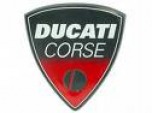Ducati-History

Ducati: a factory of ideas
"Ducati was born on July 4th 1926 thanks to the efforts of engineer Antonio Cavalieri Ducati and his three sons: Adriano, Bruno and Marcello. These three, put together, summed up a total of 50 years of age. Adriano who was 20, was a passionate radio technician: he had managed to beat the world distance record for transmitters of minimal power using a tiny - almost microscopical - short wave transmitter. With only 60 Watts, the power of a light bulb, he had estabilished the first steady radio connection between Italy and America. It was 1924.
Following this record, the Italian Ministry of the Navy bought Adriano's radio to use it for naval radio communications and it was so that ships travelling through the Oceans were able to connect with the five Continents at any time. In 1926 Guglielmo Marconi arrived at the University of Bologna to receive his Honorary Degree in Electrical Engineering and that same year, in that same city, the Ducati family founded the "Societa' Scientifica Radio Brevetti Ducati" to make radio-electrical apparel. It was the only company to make such apparel in Italy at the time.
Ducati began producing an electrolitic condenser which was given the name of "Manens" which in Latin means "steady". And a steady value of capacity was fundamental for radio circuitry. The Ducati brothers built a few specimens of their condenser which they sent to renowned radio technicians in Europe and America for testing and the response was enthusiastic. A little factory was thus founded, in Bologna, via Guidotti n. 51, right downstairs of their new apartment. About 10 years later the factory employed 100 people and had an area of 200 sq metres.
From 1935 Ducati also started making variable condensers, once more for radio applications. To do this, Ducati began to do mechanical construction, starting from aluminium sheets from which they made the blades for the condensers. It was for this reason that Ducati, first in Italy, bought from Switzerland the famous "Genevois" a high precision punching and holing machine. To put it at work it became necessary to air-condition the factory since it was a very precise machine that built parts for variable condensers that required no adjustment after being made. It was the beginning of Ducati Precision Mechanics.
In 1935 Ducati moved to Borgo Panigale, Bologna, where a very modern factory had been designed by the Ducati brothers and built precisely at Ducati's own requirements. In 1940 the war begun, and in 1945 the factory was completely destroyed by a terrible bombing. At the start of the war, the Ducati family employed over 7000 people. Worried for the future, they opened in Bologna, Florence and Rome three Research laboratories named "Post" where possible products for the after-war were studied and designed.
Ducati production in those years of reconstruction was extremely varied and creative. The most different objects came out of its factory: among them: the famous electric razor "Raselet", the futuristic interphone "Dufono", the electro-mechanical caclulator "Duconta", and then again cameras, juke-boxes, movie cameras. After producing frigidaires and their compressors, Ducati turned its attention to bicycles with the intention of motorising them.
Italy was rapidly converting from a mainly agricultural Country to a mostly industrial economy and it needed a motorized means of transport accessible to everybody. Everyone owned a bicycle: what could have been simpler than tranforming them into small motorbikes?
Right at the end of the war a small factory named SIATA was founded in Turin, directed by an amateur of mechanics, a lawyer in real life, who had patented and had started production of a refined 4 stroke 48 cc auxiliary motor for bicycles, the "Cucciolo" (meaning "Pup" pronounced COO-tchow-low). But the assets of SIATA were not big enough to satisfy the demand and so Ducati bought the tools and the rights to make the Cucciolo and completed the production and marketing processes, starting production in the foundry of Cameri, owned by Ducati itself.
The success of the Cucciolo went above any expectation: more than 100'000 were sold all over the world! The history of the Cucciolo is paved with success and even a popular song was composed in its praise: "vieni con me, ti portero' sul Cucciolo... il motorino e' piccolo.... ma batte con il mio cuor" (“come with me, I will take you on the Cucciolo.... the engine is small.... but it beats with my heart”)
This text appeared in Italian as the introduction of the book "Motociclismo racconta la Storia della Ducati" by Bianchi and Masetti, dec 1997.
